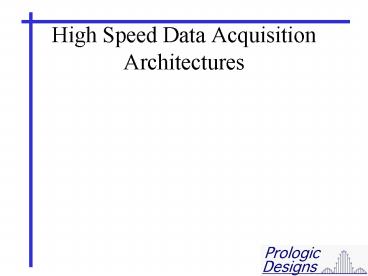High Speed Data Acquisition Architectures
Title:
High Speed Data Acquisition Architectures
Description:
Title: High Speed Data Acquisition Architectures Author: John C Last modified by: John C Created Date: 11/30/2005 8:57:28 PM Document presentation format –
Number of Views:195
Avg rating:3.0/5.0
Title: High Speed Data Acquisition Architectures
1
High Speed Data Acquisition Architectures
2
Some Basic Architectures
- Non-Buffered (streaming)
- FIFO Buffered
- Multiplexed RAM
- Ping Pong Multiplexed RAM
- Dual Port RAM
3
Streaming Interface Block Diagram
4
Advantages / Disadvantages of Streaming
- Advantages
- Simple, low cost
- If only a small sample block is required,
internal DSP RAM can be used for buffering - Processing takes place in real time
- Disadvantages
- Limited sampling speed
5
FIFO Buffered Block Diagram
6
Advantages / Disadvantages of FIFO Buffered
- Advantages
- Simple
- Allows initial samples to be processed while
subsequent samples are collected - Moderate cost, low to moderate density
- Fast 100MHz clock rates readily available
- Disadvantages
- Sequential access, unneeded samples must be
unloaded - Calculations cannot be done in place
7
Multiplexed RAM Block Diagram
8
Advantages / Disadvantages of Multiplexed RAM
- Advantages
- Low cost
- High density
- Random access
- Calculations can be done in place
- Disadvantages
- More complex than FIFO, requires multiplexers,
counters, etc - RAM only available after all data has been
collected. Processing of first samples cannot
proceed in parallel with subsequent data
collection - RAM access time may require that ADC data be
demultiplexed into multiple data streams
9
Ping Pong Multiplexed RAM Block Diagram
10
Advantages / Disadvantages of Ping Pong
Multiplexed RAM
- Advantages
- High density
- Random access
- One data buffer is always available to DSP/Host,
so next data set is collected while first data
set is processed - Calculations can be done in place
- Disadvantages
- Complex, requires dual RAM banks, several
multiplexers, counters, etc - RAM access time may require that ADC data be
demultiplexed into multiple data streams
11
Dual Port RAM Block Diagram
12
Advantages / Disadvantages of Dual Port RAM
- Advantages
- Simple
- Random access
- First data point is available for processing
immediately - Calculations can be done in place
- Disadvantages
- Low density, high cost
- RAM access time may require that ADC data be
demultiplexed into multiple data streams
13
Interfaces
- USB 2.0
- 10/100 LAN
- Gigabit LAN
- Parallel Bus (PXI, CPCI, VME, VXI, etc)
14
USB 2.0
- Advantages
- Simple hardware
- 480 Mbps
- Widely available on desktops and laptops
- Disadvantages
- Can require substantial software overhead
- Sharing bus with over devices limits bandwidth
- Must be in close proximity to computer
15
10/100 LAN
- Advantages
- Widely available on desktops and laptops
- Operates over long distances
- Disadvantages
- Typically requires coprocessor
- Can require substantial software overhead
- Sharing bus with other devices limits bandwidth
16
Gigabit LAN
- Advantages
- 1000 Mbps
- Operates over long distances
- Disadvantages
- Typically requires embedded SBC with operating
system support - Can require substantial software overhead
- Sharing bus with other devices limits bandwidth
17
Parallel Bus
- Advantages
- Fastest possible data transfer
- DSP may not be required for some applications
- Can use off the shelf SBC as controller/host
processor - Host processor/OS could support other interfaces
(e.g. Gigabit LAN) - Disadvantages
- Expensive (requires SBC)
- Size, power consumption
18
ADC14100-USB Block Diagram
19
ADC14100-USB Front Panel
20
ADC14100-USB Rear Panel
21
ADC14100-USB Features
- 14 Bit 100 MSPS ADC
- Analog Devices ADSP-21262 DSP
- 256K x 18, 100 MHz FIFO memory
- USB 2.0 Interface
- RS232 Interface
- Hardware decimator for lower sample rates at full
analog bandwidth - 3 software selectable clock sources
- Internal 100 MHz oscillator
- Internal 80 MHz oscillator
- External clock































